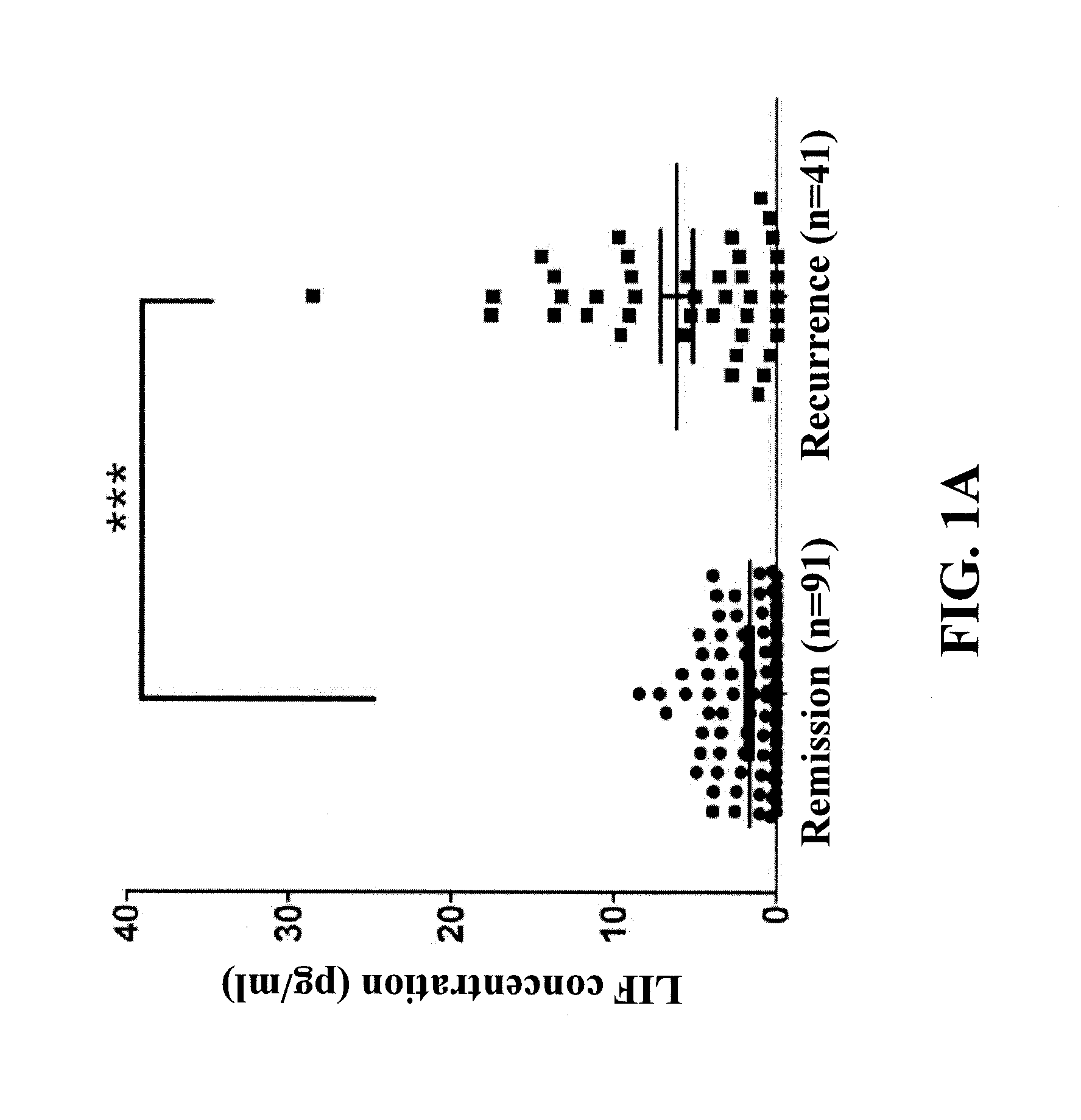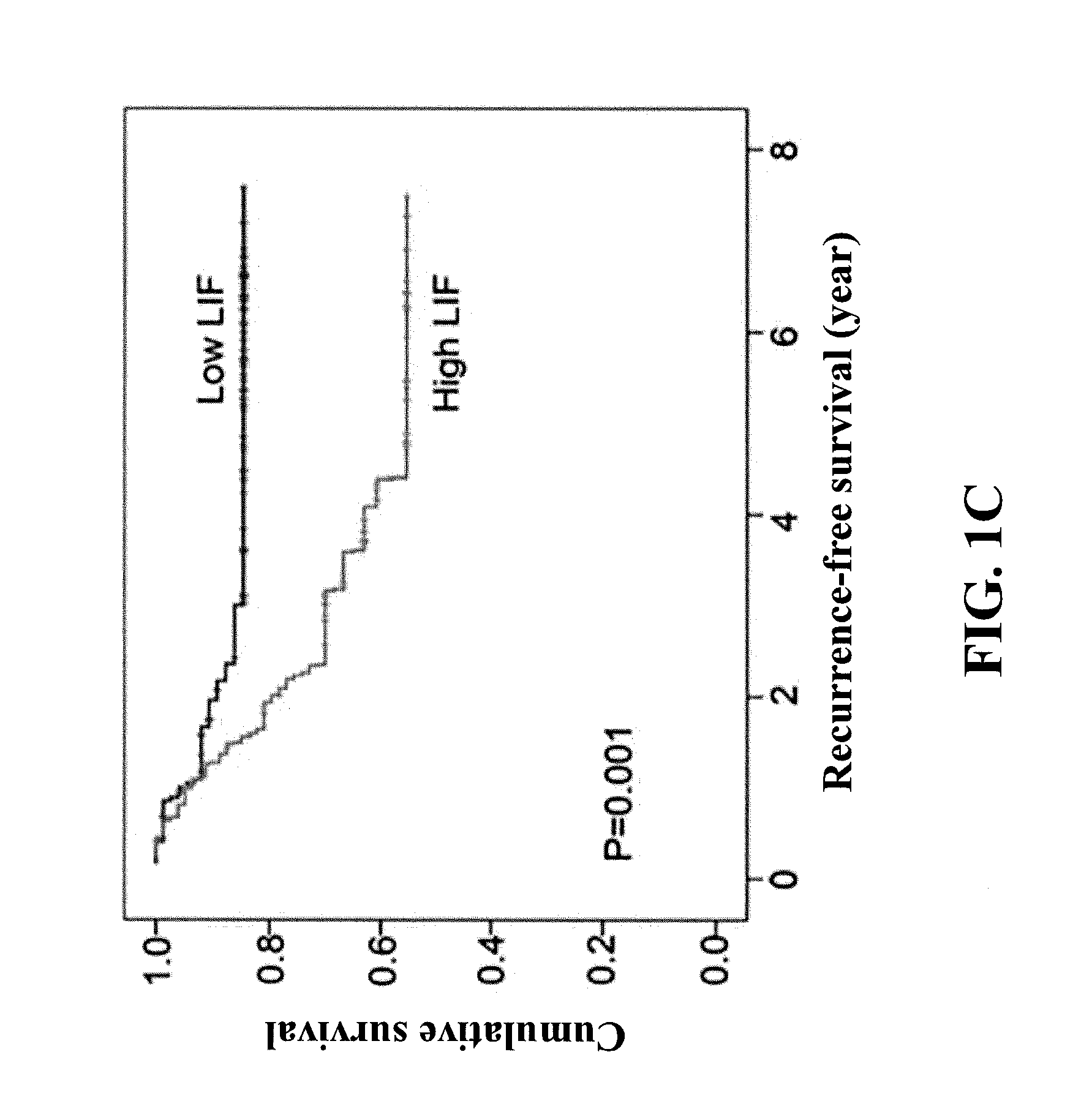Evaluation of cancer diagnosis following cancer radiotherapy and potentiation of cancer radiotherapy
a cancer diagnosis and radiotherapy technology, applied in the field of cancer diagnosis following radiotherapy, can solve the problems of radiation affecting the healthy cells of patients, tumor cells,
- Summary
- Abstract
- Description
- Claims
- Application Information
AI Technical Summary
Benefits of technology
Problems solved by technology
Method used
Image
Examples
example 1
Relationship of a Leukemia Inhibitory Factor Concentration in a Serum Sample of a Nasopharyngeal Cancer Patient Prior to Cancer Radiotherapy, and Cancer Diagnosis Following the Cancer Radiotherapy
[0049]Firstly, 132 nasopharyngeal cancer patients' serum samples prior to cancer radiotherapy were obtained. Then, all the patients completely underwent the cancer radiotherapy, the dosage thereof was 6840-7600 cGy / 7-8 weeks. During a tracking period after the radiotherapy, the nasopharyngeal cancer of all patients was diagnosed with recurrence or remission. As shown in FIG. 1A, the nasopharyngeal cancer of 91 patients was diagnosed with remission, and the nasopharyngeal cancer of the other 41 patients was diagnosed with recurrence. Additionally, the leukemia inhibitory factor concentration in the serum samples of patients suffering from nasopharyngeal cancer diagnosed with remission was substantially lower than that diagnosed with recurrence.
[0050]As shown in FIG. 1B, a receiver operating ...
example 2
Expression of Leukemia Inhibitory Factor and its Receptor in a Nasopharyngeal Tumor Tissue of a Nasopharyngeal Cancer Patient, and that in the Patient's Nasopharyngeal Normal Tissue
[0053]Firstly, an immunohistochemical staining was practiced to stain a nasopharyngeal tumor tissue of a nasopharyngeal cancer patient and a nasopharyngeal normal tissue thereof. As shown in FIGS. 2A and 2B, the leukemia inhibitory factor expression level in a nasopharyngeal tumor tissue is higher than that in a nasopharyngeal normal tissue, and the leukemia inhibitory factor receptor expression level in a nasopharyngeal tumor tissue is also higher than that in a nasopharyngeal normal tissue.
[0054]A Western blotting was practiced to further confirm the foregoing result. Similarly, the leukemia inhibitory factor expression level in a nasopharyngeal tumor tissue is higher than that in a nasopharyngeal normal tissue, and the leukemia inhibitory factor receptor expression level in a nasopharyngeal tumor tissu...
example 3
Effect of Leukemia Inhibitory Factor on the Growth of a Nasopharyngeal Cancer Cell In Vivo or In Vitro
[0056]6×103 TW06 cells were seeded, and then cultivated at 37° C. overnight. These cells were treated with PBS, a soluble leukemia inhibitory factor receptor (1 μg / ml), leukemia inhibitory factor (10 ng / ml), or a soluble leukemia inhibitory factor receptor plus leukemia inhibitory factor. After which, an xCelligence real time cell analyzer (Roche Applied Science) was used to detect the cell growth at a certain time point after this treatment.
[0057]As shown in FIG. 3A, the growth of cells with leukemia inhibitory factor treatment is the most obvious; in contrast, that with soluble leukemia inhibitory factor receptor treatment is the most unobvious. Furthermore, the growth of cells with soluble leukemia inhibitory factor receptor and leukemia inhibitory factor co-treatment is worse than that with PBS treatment.
[0058]In addition, a TW06 cell transfected with firely luciferase 2 reporte...
PUM
| Property | Measurement | Unit |
|---|---|---|
| concentration | aaaaa | aaaaa |
| volume | aaaaa | aaaaa |
| volume | aaaaa | aaaaa |
Abstract
Description
Claims
Application Information
 Login to View More
Login to View More - R&D
- Intellectual Property
- Life Sciences
- Materials
- Tech Scout
- Unparalleled Data Quality
- Higher Quality Content
- 60% Fewer Hallucinations
Browse by: Latest US Patents, China's latest patents, Technical Efficacy Thesaurus, Application Domain, Technology Topic, Popular Technical Reports.
© 2025 PatSnap. All rights reserved.Legal|Privacy policy|Modern Slavery Act Transparency Statement|Sitemap|About US| Contact US: help@patsnap.com



